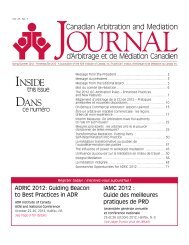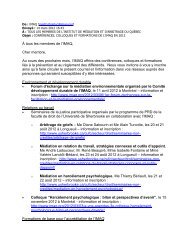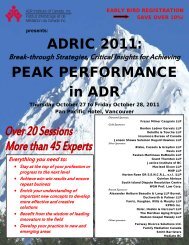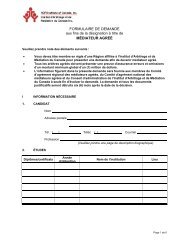Printemps 2011 - ADR Institute of Canada
Printemps 2011 - ADR Institute of Canada
Printemps 2011 - ADR Institute of Canada
You also want an ePaper? Increase the reach of your titles
YUMPU automatically turns print PDFs into web optimized ePapers that Google loves.
least at the risky point. 32Perception and appraisal <strong>of</strong> one’s own emotions are central toemotional intelligence. However, equally important in becomingemotionally intelligent is recognizing and dealing appropriatelywith the emotions <strong>of</strong> others.Perception <strong>of</strong> Emotions in OthersThere is significant advantage to being able to accurately reademotional clues displayed by others during a negotiation. Suchclues could well provide information about their reservation point,underlying interests, and constraints that might not otherwise berevealed in conversation. For example agitation or strong negativeemotion such as anger may be displayed by a party as a reservationpoint is approached. Signs <strong>of</strong> embarrassment might be shownwhen questions are asked about information that the party does towant to reveal. Important information is also provided by how theperson copes with such feelings. For example facial expressions<strong>of</strong> anger may be shown but body posture reveals minimizationand tightness. This disconnect may indicate unawareness, denialor repression. Conversely a person may show anger in the facetogether with a menacing posture and loud speech. In this case theperson may still be unaware <strong>of</strong> his feelings but is willing to expressthem.It will come as no surprise that most information about emotion istransmitted non-verbally. What is surprising is that research ongeneral communication <strong>of</strong> information has been found that only7% <strong>of</strong> communication is verbal while the remainder – a huge 93%— is nonverbal. 33 This indicates that we get far more informationfrom nonverbal language than we do from the words that are spoken.However since there is such a myriad <strong>of</strong> nonverbal informationit is <strong>of</strong>ten difficult to figure out what is important and what isjust extraneous. Also some <strong>of</strong> the popular literature on readingbody language erroneously puts forward single and absolute interpretations<strong>of</strong> gestures – such as crossed arms always meanshostility – without taking into consideration the context <strong>of</strong> the gestureor the person’s typical gestures.Bolton has devised several guidelines for interpreting nonverballanguage which are simple, practical and effective. 34 They include:focus attention on the most helpful clues; read nonverbal languagein context; note discrepancies, and be aware <strong>of</strong> your own feelingsand body language. In terms <strong>of</strong> where to focus attention most behavioralscientists agree that the face is the most important source<strong>of</strong> information about emotions. As noted by Paul Ekman andWallace Friesen:The rapid facial signals are the primary system for expression<strong>of</strong> emotion. It is the face you search to know whether someoneis angry, disgusted, afraid, sad etc. Words cannot always describethe feelings people have; <strong>of</strong>ten words are not adequateto express what you see in the look on someone’s face at anemotional moment. 35The ability to perceive emotion in others using the eyes and surroundingfacial tissue has been found to be remarkably accurateand it appears that we may be hard wired for such recognition. 36Without any training we are able to differentiate many differentand subtle emotions using only this facial area. Perhaps this iswhy advice about using a poker face and displaying no emotionduring negotiations is so popular. One caution - when observingthe changing facial expressions <strong>of</strong> the other side it is advisable todo it in such a way that appears natural and non-threatening. Youcertainly don’t want the other side to become anxious due to yoursurveillance <strong>of</strong> them.Increased animation and liveliness can also tell us nonverballywhat is important to a person. We have all been involved in conversationswhere we or the other person suddenly becomes animated,as if extra energy has suddenly been accessed. Determiningwhich topic was discussed during this period <strong>of</strong> increasedanimation will reveal what matters to that person. This can be <strong>of</strong>particular importance when determining underlying interests duringa negotiation or in understanding the person more fully.With regard to gestures, no single motion ever stands alone as itusually forms part <strong>of</strong> a pattern. Nor does it usually have the sameconsistent meaning across individuals. Thus gestures must be interpretedand understood in the context <strong>of</strong> the situation. 37 And suchcontext includes other body movements at the time, the person’swords at the time and the typical gestures <strong>of</strong> the person over time.If a person seldom crosses his arms, when he does it could wellmean that he is distancing himself from the topic under discussionor indicating hostility. However if he tends to do it all the time,especially when he is relaxed, then you will know when he is relaxed.Sudden changes, especially changes in the position <strong>of</strong> thetorso, can convey important information. Sudden leaning forwardor moving backward may display the level <strong>of</strong> interest in the discussion,however, it is important to take the individual’s typicalmovements into account before drawing such conclusions.Another guideline in interpreting nonverbal behavior is to noteany disconnect between the words spoken and body language displayed.For example, shouting the words “I am not angry” whileappearing red in the face and banging the table shows a big discrepancy.When there is such disconnect between the words spokenand the body language, both messages are important. The personbanging the table while denying the feeling <strong>of</strong> anger is clearingconflicted about feeling angry and most likely unable to admit tosuch feelings.Surprisingly awareness <strong>of</strong> what other people are feeling can beaccessed through our own feelings. There is new research indicatingthat our brain contains neurons, called mirror neurons, whichrespond in the same way to other’s emotions as if we were feelingthe emotion ourselves. 38 Scientists have postulated that these types<strong>of</strong> neurons underlie the human capacity for empathy. It is possiblethat mirror neurons might even be related to the unconscious activity<strong>of</strong> bodily mirroring others when we are in sync with themduring conversations. In fact therapists do this intentionally to betterunderstand what others may be feeling.Le Journal canadien d'arbitrage et de médiation9







